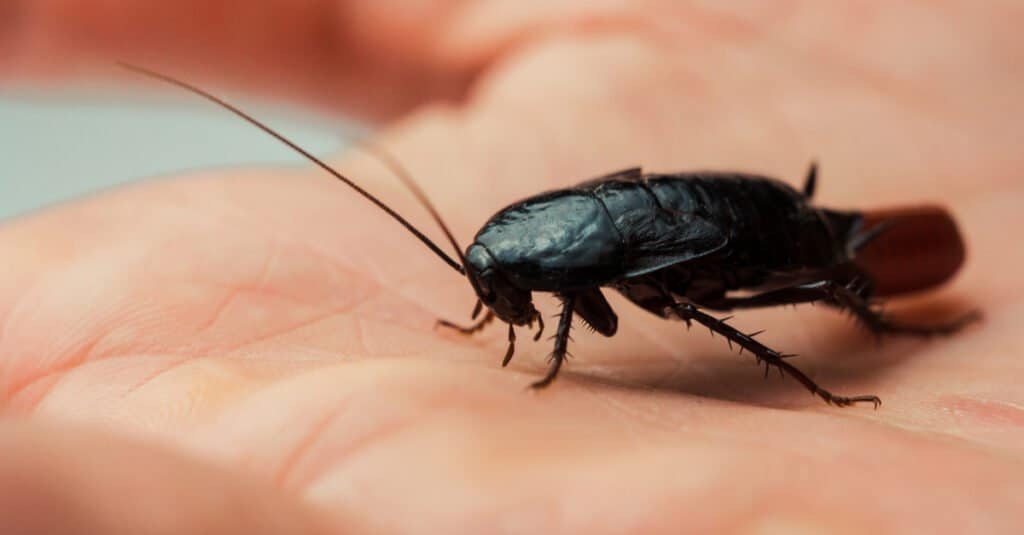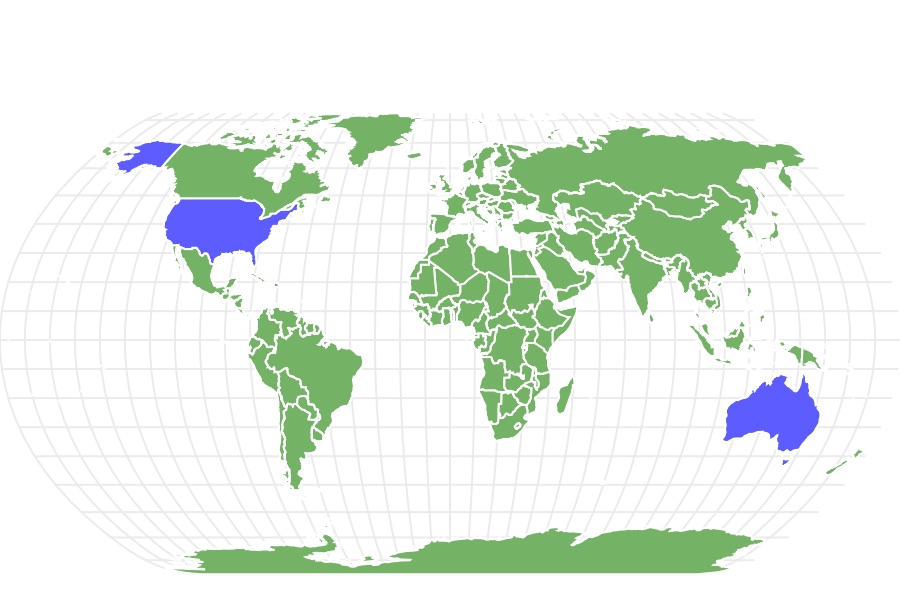Oriental Cockroach
Blatta orientalis
Unlike other cockroach species that live indoors living off humans, oriental cockroaches are outdoor scavengers.
Advertisement
Oriental Cockroach Scientific Classification
- Kingdom
- Animalia
- Phylum
- Arthropoda
- Class
- Insecta
- Order
- Blattodea
- Family
- Blattidea
- Genus
- Blatta
- Scientific Name
- Blatta orientalis
Read our Complete Guide to Classification of Animals.
Oriental Cockroach Conservation Status
Oriental Cockroach Facts
- Name Of Young
- Nymph
- Group Behavior
- Infestation
- Fun Fact
- Unlike other cockroach species that live indoors living off humans, oriental cockroaches are outdoor scavengers.
- Diet
- Omnivore
- Lifestyle
- Nocturnal
- Favorite Food
- Decaying plant and animal matter
- Common Name
- Oriental cockroach
- Nesting Location
- In sewers, piping, home basements
View all of the Oriental Cockroach images!
Unlike other cockroach species that live indoors living off humans, oriental cockroaches are outdoor scavengers.
Summary
The Oriental cockroach is a large, shiny cockroach with a dark brown or almost black color. Like other cockroach species, oriental cockroaches are scavengers. However, they live in outdoor habitats rather than indoors. Oriental cockroaches are also called water bugs mainly because they thrive on wet, decaying organic matter in dark, moist places such as sewers. Oriental cockroaches are rarely found in homes. However, they may enter in search of water through the plumbing system.
Species, Types, and Scientific name
The Oriental cockroach (Blatta orientalis) is a cockroach species belonging to the family Blattidae and other cockroach species. Cockroaches and the related termites both belong to the order Blattodea. This order includes about 4,400 species of roaches grouped into 500 genera and at least 3000 termite species in 300 genera.
Although native to the Black and Caspian Seas region, Oriental cockroaches are now found in various locations worldwide. Oriental cockroaches are also called water bugs because of their tendency to live in damp places. People sometimes refer to them as “black beetle cockroaches,” a reference to their smooth, dark bodies.
Water bugs are outdoor scavengers. They’re typically found in sewers, damp basements, drains and other plumbing systems. Like other cockroaches, water bugs are nocturnal. They’re even more elusive because of their tendency to stay in places that humans rarely inspect.
Appearance: How To Identify Oriental Cockroaches
Oriental cockroaches have a shiny black or reddish-brown color. Adults exhibit sexual dimorphism, meaning the males and females are different in appearance. Water bugs are among the largest of all cockroach species.
Adults can grow to about 2.5cm (0.98inches) in length. The males are typically smaller in size compared to females. Males are typically about 1,8–2.9cm (0.71–1.14 in) in length. Conversely, females are about 2.0–2.7cm (0.79–1.06) in length.
The males have shortened wings that are typically about three-quarters of their body length, exposing the last few segments of their abdomen. Females are bigger and practically wingless. They have a short non-functional wing pad covering just the first few segments of their body below the head. The wings in both male and female oriental cockroaches are non-functional).
Water bugs often come out of moist gutters and sewers during warm summer months. They typically come out at night, and you might spot them congregating in dark, moist places where they’re undisturbed. Their egg capsules and characteristic musty odors are common signs to watch out for that indicate their presence.

Oriental Cockroaches have a shiny black or reddish-brown color.
©Yuliia Hurzhos/Shutterstock.com
Habitat: Where to Find Oriental Cockroaches
This bug is native to the Black and Caspian Seas. However, it is not found on practically all continents in the right habitat. Oriental cockroaches don’t spread as fast as other cockroach species.
In places where they exist, water bugs prefer to stay in dark, moist places, especially sewers and drains. They thrive best in temperatures between 68 to 84 degrees. In the home, they typically stay in damp basements and crawl spaces. You can also spot these bugs in bushes, where they hide under piles of leaves, mulch, flower beds, firewood and under stoops.
Diet: What Do Oriental Cockroaches Eat?
Like other species of cockroaches, water bugs are scavengers. However, since they do not live in homes, they have a slightly different diet. These bugs live in sewer pipes where they survive on filth.
What Eats Oriental Cockroaches?
Like all bugs, oriental cockroaches have a lot of natural enemies. Amphibians such as toads and frogs feed on them. They’re also a snack for small mammals like shrews and mice. Some other insects, such as beetles and arachnids like spiders, attack and feed on them.
What Does the Oriental Cockroach Eat?
The water bug is a scavenger that feeds on all kinds of decaying plant and animal matter. They can typically survive on starchy foods and garbage. Although water bugs can survive for up to a month without food, they rely heavily on water. They will die off within two weeks if they cannot find a water source.
Prevention: How to Get Rid of Oriental Cockroaches
Although water bugs typically don’t get into homes, they’re prolific household pests in parts of the United States, Europe, South America and Australia. Water bugs are particularly difficult to get rid of compared to other cockroaches. Although insecticides can easily kill them, the eradication must be complete. Females can hatch new nymphs within a few weeks without males, and an infestation may restart.
To keep them away, you can apply an insecticide spray to create a barrier around your home. Insecticide granules, dusters and bait traps work against them as well. Since an infestation is so difficult to treat, hiring a professional is always best.
Similar Animals
View all 66 animals that start with OOriental Cockroach FAQs (Frequently Asked Questions)
Are oriental cockroaches dangerous?
Oriental cockroaches don’t have stinging mouthparts. However, they’re still considered dangerous because they transfer bacteria and pathogens. They stay in bacteria-ridden water and can transfer these germs through their legs to utensils, countertops and dishes if they enter the home, leading to food poisoning or diseases like dysentery.
Do oriental cockroaches bite?
Oriental cockroaches can potentially bite people, but they rarely do so. However, they may bite people during large infestations or if food is scarce. Their bit is typically painless, and they’re not venomous.
Why do I have oriental cockroaches?
Oriental cockroaches typically live inside sewers, drains and other damp places. They’re also abundant in outdoor environments where the dead plant and animal matter they feed on is abundant. They only enter homes in search of water. Leaking pipes and other plumbing leaks will likely attract these bugs into your home.
Where do oriental cockroaches lay eggs?
Oriental cockroaches typically lay eggs in capsules. The female carries the egg for about 30 hours before dropping them near a food supply to hatch.
Thank you for reading! Have some feedback for us? Contact the AZ Animals editorial team.
Sources
- Holders Pest Solutions, Available here: https://www.holderspestsolutions.com/pest-library/cockroaches/oriental-cockroaches/
- Wikipedia, Available here: https://en.wikipedia.org/wiki/Oriental_cockroach#cite_note-auto-7
- Arrow Exterminators, Available here: https://www.arrowexterminators.com/learning-center/pest-library/cockroaches/oriental-cockroaches
- Pest World, Available here: https://www.pestworld.org/pest-guide/cockroaches/oriental-cockroaches/
















